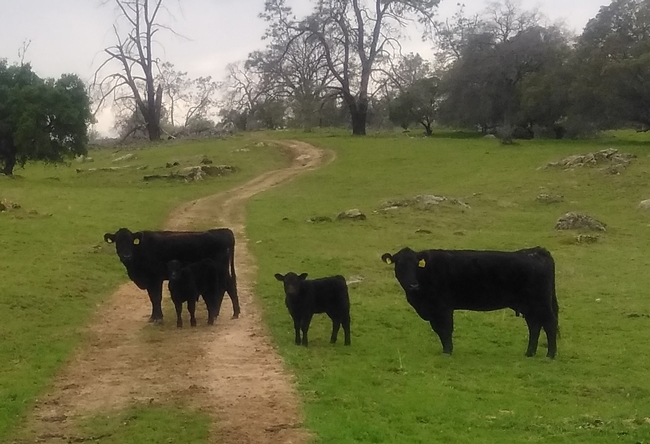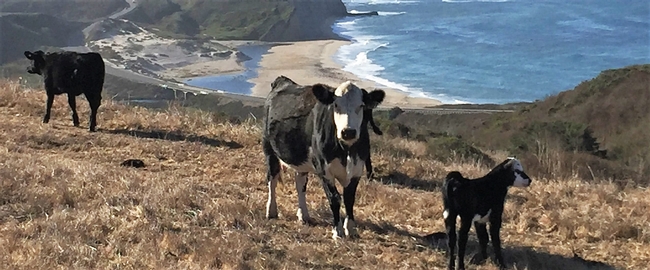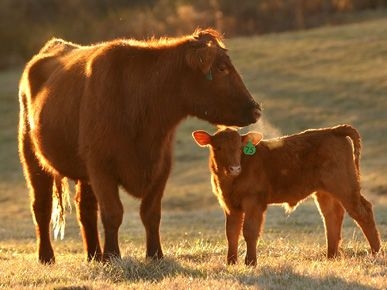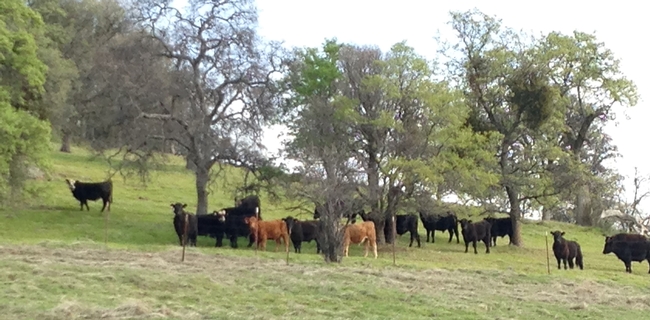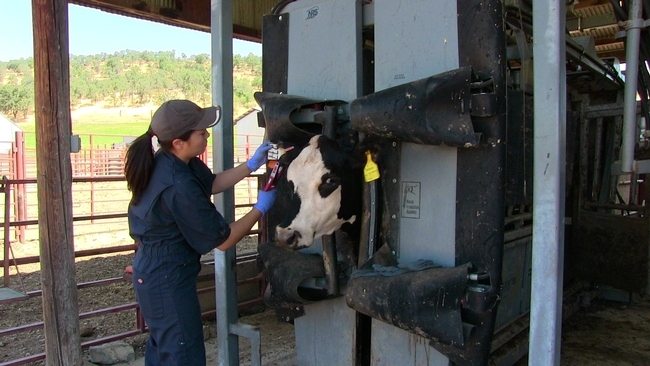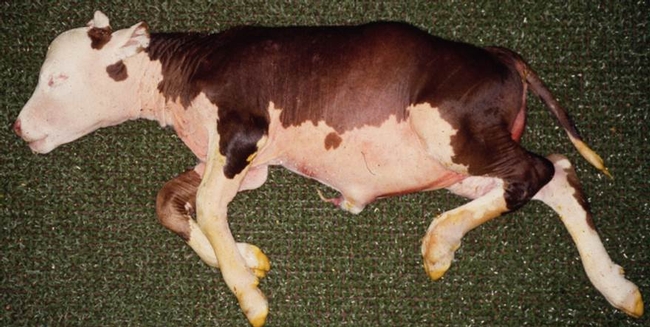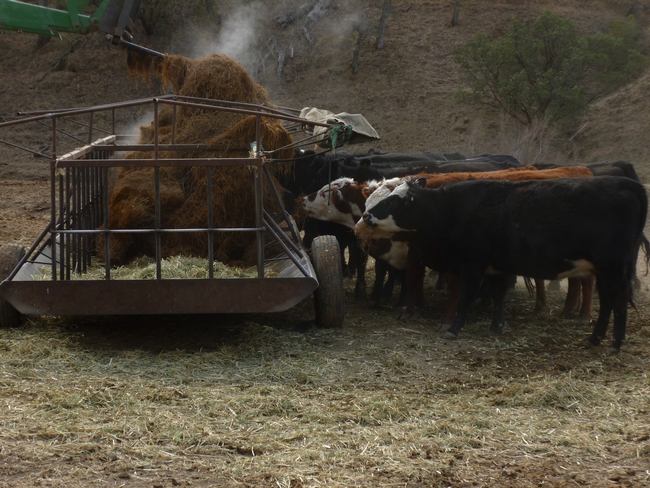Posts Tagged: cattle
UC releases latest cost and returns for ranchers raising beef cattle
Among California's agricultural commodities, cattle rank fifth in revenue. The University of California Agriculture and Natural Resources' Agricultural Issues Center has released a new study showing the cost and returns of a beef cattle operation.
“Ranchers can use UC beef-cattle cost studies to guide their production decisions, estimate their own potential revenue, prepare budgets and evaluate production loans,” said Rebecca Ozeran, UC Cooperative Extension livestock and natural resources advisor for Fresno and Madera counties.
The study estimates costs and returns of a representative owner-operated beef cattle operation located on rangeland in the Central San Joaquin Valley and foothills of Madera and Fresno counties. The study describes a 200-head cow-calf operation and includes pasture costs on the basis of the rental per animal unit month.
The analysis is based upon a hypothetical cow-calf operation, where the cattle producer both owns and leases rangeland. The “typical” ranch in the Central San Joaquin Valley is an owner-operated cow-calf operation, often relying on multiple private leases. The operations described represent production practices and materials considered typical of a well-managed ranch in the region.
Input and reviews were provided by ranch operators, UC Cooperative Extension farm advisors and other agricultural associates. The study describes in detail the assumptions used to identify current costs for the cow-calf herd, material inputs, cash and non-cash overhead. The cost calculations in this study are based on economic principles that include all cash costs and overhead costs. The study also includes a “ranging analysis” to show potential net returns over a range of market prices. Other tables show the average costs and revenues, the distribution of monthly costs and revenues over the year, and the annual equipment, investment and business overhead costs.
“In addition to producing meat, cattle play an important role in California's landscape and environment by grazing on vegetation that could fuel wildfire,” Ozeran said. “Ranching therefore has ecological and social impact on rural and fire-prone communities. If we can help ranchers remain economically viable, then we help support local stewardship of productive natural landscapes and contribute to fire resiliency and food security.”
The new study, “Sample Costs for Beef Cattle, Cow-Calf Production - 200 Head Operation, Central San Joaquin Valley - 2019” is authored by Ozeran, Donald Stewart, staff research associate of the University of California Agricultural Issues Center; and Daniel A. Sumner, director of UC Agricultural Issues Center.
This study and other sample cost of production studies for many commodities are available for free download at http://coststudies.ucdavis.edu. The program is supported by UC Agriculture and Natural Resources, including both Agricultural Issues Center and UC Cooperative Extension, and the UC Davis Department of Agricultural and Resource Economics.
For more information, contact Stewart at (530) 752-4651 or destewart@ucdavis.edu. To discuss this study with a local UC Cooperative Extension farm advisor, contact your county UC Cooperative Extension office https://ucanr.edu/About/Locations or contact Rebecca Ozeran at (559) 241-6564 or rkozeran@ucanr.edu.
Thinking about going into the cattle business? New UC cost study for beef cattle operation helps ranchers plan
A new study on the costs and returns of a beef cattle operation has been released by the University of California Agriculture and Natural Resources' Agricultural Issues Center. The estimated costs can help ranchers and land management agencies on California's Central Coast make business decisions.
“This cost study can be a valuable tool for someone who is thinking about going into the cattle business because it will help them think through the various categories of costs, and aid in developing a budget and business plan,” said Devii Rao, University of California Cooperative Extension livestock and natural resources advisor for San Benito, Monterey and Santa Cruz counties.
Based on the typical costs of a 300-head cow-calf operation, the study estimates costs of an owner-operated beef cattle operation located on leased rangeland in the Central Coast region of California. The cost calculations in this study are based on economic principles that include all cash costs and uses the rental cost per animal unit month (AUM) as a cost of pasture.
“The study can also be used by a seasoned rancher,” said Rao, a co-author of the study. The first cost table has an empty column titled, “Your Costs.” This is probably one of the most useful pages for the experienced rancher. Producers can use this column to enter their own costs and compare them to the costs in the study. It will help them think about where they can make changes in their operation to reduce costs.”
The analysis is based upon a hypothetical cow-calf operation, where the cattle producer leases all rangeland. The “typical” ranch in the Central Coast is an owner-operated cow-calf operation using multiple private and public leases. The practices described represent production practices and materials considered typical of a well-managed ranch in the region.
Input and reviews for this study were provided by ranch operators, UC ANR Cooperative Extension farm advisors and other agricultural associates. A narrative describes the assumptions used to identify current costs for the cow-calf herd, material inputs, cash and non-cash overhead. A ranging analysis table shows profits over a range of average market prices. Other tables show the costs and revenue for production, monthly summary of costs and revenue, and the annual equipment, investment and business overhead costs.
“This study will also be of value to land management agencies that lease their lands for cattle grazing,” she said. “Many agency staff are not familiar with the different aspects of cow/calf operations. For land management agency staff, the most useful portion of the study is likely to be the Operations Calendar, which summarizes the timeline for breeding, branding, vaccinating, calving, shipping, etc.”
“Sample Costs for Beef Cattle – Central Coast Region – 2018” can be downloaded for free from the UC Davis Department of Agricultural and Resource Economics website at https://coststudies.ucdavis.edu. Sample cost of production studies for many other commodities are also available at the website.
For additional information or an explanation of the calculations used in the studies, contact Donald Stewart at the Agricultural Issues Center at (530) 752-4651 or destewart@ucdavis.edu.
For information about beef cattle production in the Central Coast region, contact Rao at drorao@ucanr.edu.
UC helps cattle ranchers estimate costs and returns of beef production
The cattle industry in California has undergone dramatic changes over the last few decades. International competition and opportunities, new regulatory requirements, fluctuating feed costs, changing consumer demand, economies of scale and competing land uses all affect the bottomline in cattle ranching. Ranchers have experienced increasing production costs while revenue has not kept pace with costs.
To help ranchers make business decisions, new cost studies for beef cattle production have been released by UC ANR Agricultural Issues Center and UC Cooperative Extension.
Sample costs and returns for beef cattle production in the northern Sacramento Valley are presented in these studies. The studies are titled “Sample Costs for Beef Cattle, Cow–Calf Production,” “Sample Costs for Beef Cattle, Yearling/Stocker Production” and “Sample Costs for Beef Cattle, Finished on Grass.”
"These studies are useful to new and experienced ranchers, lenders and other agribusiness companies, as well as government officials, researcher and students who want to know basics of ranch practices and the costs and returns that can be expected for a well-managed operation,” said Daniel Sumner, director of the UC Agricultural Issues Center. “The studies show ranges of net returns under alternative price scenarios to help indicate sensitivity of returns to cattle market conditions."
The analyses are based on a hypothetical well-managed ranching operation using practices common to the northern Sacramento Valley. The three studies are based on a herd of 300 cows and bred heifers, 60 yearling heifers and 15 bulls. An 11 percent cull rate is applied to the herd. An 89 percent calf crop with three percent mortality before weaning is assumed.
All rangeland and pasture is rented per animal unit month. Ranging analysis tables show net revenue over a range of prices. The costs, materials and operations shown in this study will not apply to all ranches. Ranchers, UC Cooperative Extension farm advisors, and other agricultural associates provided input and reviewed the methods and findings of the study.
Free copies of these studies and other sample cost of production studies for additional commodities are also available. To download the cost studies, visit the UC Davis Department of Agricultural and Resource Economics website at https://coststudies.ucdavis.edu.
The cost studies program is funded by the UC Agricultural Issues Center and UC Cooperative Extension, both of which are part of the UC Division of Agriculture and Natural Resources, and the UC Davis Department of Agricultural and Resource Economics.
For more information or an explanation of the calculations used in the studies, contact Donald Stewart at the Agricultural Issues Center at (530) 752-4651 or destewart@ucdavis.edu; Larry Forero, UC Cooperative Extension farm advisor for Shasta and Trinity counties, at lcforero@ucanr.edu, or Jeff Stackhouse, UC Cooperative Extension farm advisor for Humboldt and Del Norte counties, at jwstackhouse@ucanr.edu.
NOTE: Corrections were made on July 19, 2017, to “2017 Beef Cattle Yearling/Stocker Production in the Sacramento Valley” and “2017 Beef Cattle Finished on Grass in the Sacramento Valley” to show interest calculated for 6 months as stated in the narratives of both studies, instead of 12 months.
To solve deadly cattle disease, ranchers collaborate with UC researchers at UC ANR research center
UC Sierra Foothill Research and Extension Center hosts cattle for research to commercialize vaccine
After more than 60 years of working closely with University of California Division of Agriculture and Natural Resources researchers to identify and learn how to manage a disease that causes the death of up to 90,000 calves annually, ranchers are optimistic that they are on the home stretch to getting a vaccine that will protect cattle.
Caused by tick-borne bacteria, the disease commonly known as foothill abortion is a leading cause of economic loss for California beef producers. To combat the disease, the California Cattlemen's Association is sponsoring UC vaccine trials, now in the second year, in commercial herds throughout California, Nevada and Oregon, which will facilitate commercial licensing of the product. At the same time, the UC researchers are continuing studies at the Sierra Foothill Research and Extension Center to identify the best time to vaccinate and potential side effects of the vaccine on the animals' health.
Through a 30-year partnership with the cattle industry, UC Davis veterinary immunologist Jeffrey Stott has been leading the effort to identify the organism causing the devastating disease and has successfully developed a live vaccine to protect cows against the disease.
“The vaccine is huge for the industry,” said Tom Talbot, Bishop beef producer and livestock veterinarian. “I don't think we fully understand the magnitude of the economic loss suffered from aborted calves.”
While Talbot was attending the School of Veterinary Medicine at UC Davis in the 1970s, his father purchased some cattle to breed in the mountains near Bakersfield. The following autumn, none of the calves from the Talbots' new heifers survived.
As an active member of the California Cattlemen's Association, Talbot has remained involved in the search for a cure.
While research trials demonstrated the vaccine was more than 95 percent effective in preventing the disease, UC researchers faced a major hurdle to making the vaccine commercially available to ranchers. USDA Center for Veterinary Biologics, which regulates animal vaccines, required detailed data on how the timing of vaccine delivery may impact embryo development following breeding.
“Gathering this information was not going to be easy, as it required applying careful experimental control on when animals were bred relative to when the vaccine was delivered and making frequent observations on a very large number of animals,” said Jeremy James, UC Sierra Foothill Research and Extension Center director.
The beef cattle industry and UC researchers realized that UC Agriculture and Natural Resources' 5,721-acre Sierra Foothill Research and Extension Center would provide an ideal outdoor laboratory for the critical research. The Pajaroellobacter abortibovis bacterium and pajaroello ticks that transmit the bacteria to cows naturally occur in the foothill pastures and the facility has a full-time, onsite staff to monitor the animals and collect the data.
“We're bringing together industry members and researchers in a research center framework in way that hasn't been done before for vaccine development,” said James.
The bacteria are endemic in California's coastal range and in the foothill regions of California, Southern Oregon and Northern Nevada.
Solano County-based Detar Livestock, which operates throughout California and part of Oregon, supplied 330 heifers for the experiment in 2014. Rancher Gabe Detar quickly recognized how this partnership might benefit industry across the state.
“They vaccinated half of them and there were zero abortions,” Detar said. “The cows without vaccinations had quite a few. It was a huge difference. The vaccine worked.”
This year Detar is contributing another 330 heifers. It takes 13 months to run an experiment because the vaccine has to be given to the heifer at least 60 days before she becomes pregnant, then it takes nine months until she gives birth to see if the calf survives.
In December, Stott and Myra Blanchard, a researcher with the UC Davis School of Veterinary Medicine, will begin inoculating cattle with the live vaccine for the disease, also known as epizootic bovine abortion.
The success of this research effort to defeat the cattle disease hinges on trust between the ranchers, UC scientists and the staff at the UC Sierra Foothill Research and Extension Center.
“The trust has to go in all directions,” James said. “The rancher has to trust that we'll take care of their animals because 300 cattle is a large investment. Likewise, the researchers have to trust the producers to supply the quantity and quality of animals they need to complete the work and for the staff at the Sierra Foothill Research and Extension Center to manage the animals exactly as required under their research protocols.”
Ranchers hope the vaccine will become commercially available soon to provide relief from foothill abortion disease. Until then, only the cattle participating in the research can receive the experimental vaccine.
“The disease can kill upwards of 60 to 70 percent of fetuses in infected cattle, which can jeopardize a cattle producer's business,” said Stott.
Funding for the study has been provided by the U.S. Department of Agriculture, the California Cattlemen's Association and a UC Proof of Concept Discovery Grant (grant ID no. 212263) from UC's Office of the President, with additional funding from the Russell L. Rustici Rangeland and Cattle Research Endowment and the UC School of Veterinary Medicine's Center for Food Animal Health.
For more information on how to manage cattle to prevent foothill abortion disease, visit http://anrcatalog.ucanr.edu/pdf/8566.pdf.
Livestock producers and rice farmers can work together to solve each other’s problems
UC Cooperative Extension advisor Glenn Nader believes two problems could add up to one win-win solution.
The California drought has ranchers desperate for inexpensive livestock feed. Air quality protection regulations that limit rice straw burning leave the rice industry with an abundance of typically low-quality straw to unload. Though it has rarely been done, Nader believes special treatment of rice straw will make it a nutritious cattle food. Two problems solved.
Nader will introduce producers to this new way to get through the drought at a meeting from 9 a.m. to 12 noon July 29 at the Veterans Memorial Hall, 525 W. Sycamore St., Willows, Calif.
When rice straw dries, its value as a forage declines dramatically. For 15 years, UC researchers have been trying to figure out why, but the reason for the significant change is not understood at this time.
“At one time, we thought the problem was silica in the straw,” Nader said. “We grew silica-free rice. That didn't work. We thought it was the crystallinity of molecules in the straw. We parsed apart the plant, and we still don't know.”
Ultimately, it was a rancher who suggested the scientists to put aside their desire to know why quality declines when rice straw dries and look for practical ways to get around it. Nader postponed his retirement to comply.
Normally, rice growers bale the straw two to four days after harvest. Nader and his colleagues instead baled the straw immediately after it exited the grain harvester. They stacked the green straw bales and covered them with a tarp to retain moisture and prevent spontaneous combustion. The result is a product they named “strawlage.” One worry is mold. The researchers found that treating the straw with propionic acid prevents fungus growth.
“We haven't figured everything out, but with the drought conditions as serious as they are, we feel the time is right to share our research with growers,” Nader said. “We invite producers to come to the meeting to see if this will work for their operations. Several producers who have already fed strawlage to their cattle will speak at the meeting about their experiences.”
Nader believes the UC research into using rice straw for livestock feed will be helpful throughout the world.
Asian farmers produce rice straw in great abundance and their livestock would benefit significantly if the farmers worked to maintain the plant's moisture until it reaches cattle feeding troughs.
The July 29 meeting will cover:
- Nutritional advantages of strawlage over rice straw
- The challenges of baling the straw at 50 to 60 percent moisture
- Additives to prevent mold
- How to stake and tarp strawlage
- The costs associated with the practice
- How cows that ate strawlage last year fared
“Our goal is to give producers information that will allow them to make rice strawlage during this fall's harvest,” Nader said. “Both cattle and rice producers are encouraged to attend.”

